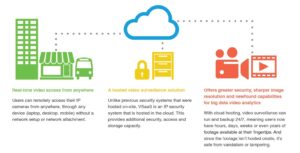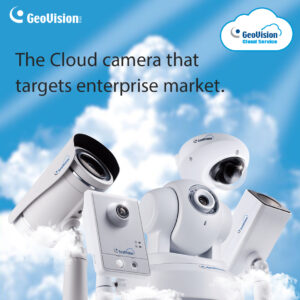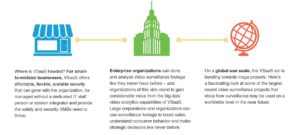
Video Surveillance as a Service is a web-hosted, wireless security system that allows users to remotely store, manage, record, play and monitor surveillance footage – entirely in the cloud. The footage is not stored onsite, and users don’t need recording software, only an IP camera system, an Internet connection and a VSaaS provider.
How does VSaaS work? VSaaS is a remote approach to video surveillance systems, as opposed to an on-site video security system. With VSaaS, IP cameras are installed at the desired location and then stream security footage to the provider’s site. Since VSaaS is managed in the cloud, users can access footage or cameras from anywhere at any time through a desktop, laptop or mobile device.
By 2020, the global market for video surveillance and VSaaS is expected to be worth $48.95 billion USD.
As the SaaS industry continues to grow and its influence spreads, learning about VSaaS now, understanding why it’s important and what it can do for your organization is crucial for staying ahead of the curve and making the best use of the latest technology from the surveillance industry.
Everything You Need to Know About VSaaS: The Past, Present & Future of Video Surveillance
What Makes VSaaS Different from Analog Security Systems?
VSaaS is a wireless surveillance system that gives users an unprecedented level of control and safety through the cloud. Cloud-based video surveillance also offers simple, minimal maintenance and an affordable and safe approach to security for system integrators who are searching for reliable and scalable alternatives to existing security systems. The following three benefits are what really set VSaaS apart from previous surveillance systems:

By 2016, IP camera sales are predicted to account for nearly 60% of total surveillance camera sales worldwide.
Additional Benefits & Key Features of VSaaS
- Data is stored in the cloud and can be backed up on a hard drive.
- Users only need IP cameras, which send and receive data through the cloud, and can function with or without a network attachment.
- With cloud video storage, surveillance footage cannot be destroyed or physically damaged.
- Receive immediate email alerts and real-time updates from anywhere.
- VSaaS is an easily scalable solution – simply add cameras and additional backup storage as needed.
- Users don’t need to invest in dedicated servers or store footage onsite.
- VSaaS is easy to set up, implement and maintain.
- Easy IP camera system control with plug-and-play capability.
- VSaaS offers increased security, more uptime and the capability to run 24/7.
- VSaaS is 100% web-based with cross-browser capability.
Uncover the Story Behind Big Data with Video Analytics
What is one of the greatest benefits of VSaaS? The opportunity to comb through a large volume of stored video footage to learn more about how traffic flows, how customers shop, how animals interact with nature or how airports function. These insights can allow end users to improve performance, sales or daily business operations. With VSaaS video analytics capabilities, users can:
- View stored footage to gain insights and make changes that produce actionable results.
- House footage in one centralized location for easy access.
- Compare and contrast changes in their industry by reviewing years or months of footage.

VSaaS Verticals: Which Industries Are Using VSaaS?
- Governments, City Surveillance & Infrastructure
- Manage and analyze everything from vehicular and pedestrian traffic to crime and vandalism.
- Banking
- 24/7 surveillance of banks and surrounding areas without the risk of storing data onsite.
- Environment/Agriculture Projects
- Monitor weather, nature and animal behavioral patterns.
- Retail
- Video surveillance is shown to be effective for decreasing crime and businesses losses.
- Transportation
- Video surveillance offers insight into traffic flow and can help decrease the instances of vandalism or theft in public transit.
- Education (K-12 & Higher Education)
- Increased security for students and staff.
- Residential Development/Housing Authorities/Hotels
- Monitor development, construction and existing sites to decrease instances of vandalism, theft or injury.
Future of VSaaS for Small-t0-Midsize Businesses, Enterprise Organizations and Global Use

Overview of the Largest New Projects in Video Surveillance: A Look at Where We’re Headed
City surveillance, retail and transit are the leading verticals for the newest and biggest projects in the video surveillance industry. For system integrators, the largest projects require a collective median of around 250 cameras.
City surveillance is the fastest growing verticals for VSaaS. A recent city surveillance project in Asia required more than 100,000 cameras while a recent public safety project in Mexico required upwards of 10,000 VSaaS cameras.
Retail Surveillance is the next largest growing vertical and is driven by purchases from individual stores and retail chains. A retail store in Canada that operates 450 branches recently upgraded from an analog surveillance system to a full-IP offering, averaging nearly 16 cameras per branch.
Transit Surveillance is another top vertical, with the largest project in 2014 migrating 1,200 cameras and 50 operators from analog to IP. The project was for the Athens Metro in Greece and also included updating a central video operation wall and incorporating full failover redundancy for each station.
Why VSaaS Is Growing & Why You Should Get Involved
IP video surveillance and IP-based systems will continue to grow and gain market share mainly due to the increased security, scalability, high-quality image resolution and video analytics capabilities.
As SaaS, video surveillance and VSaaS continue to expand, understanding how the benefits of this video management system can work for your organization will put you in a position to capitalize on the larger capabilities of VsaaS. Once you know how VsaaS can work for you, you’ll be in a position to implement a system, choose your drives and reap the many organizational and security benefits of video surveillance.
Source: Seagate Magazine



































































